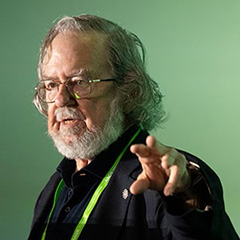NOT EVERY HYPOTHESIS IN CANCER RESEARCH HAS THE SAME STAYING POWER. Some emerge with fanfare and hype, only to fade when follow-up research fails to support a promising theory—or when an upstart steals the spotlight. But even when a promising idea gets pushed aside, it’s not always gone for good. The perfect object lesson: treating cancer by disabling its metabolism, an idea that flared and faded, and now, like a trick candle on a birthday cake, has reignited.
The basic idea behind the approach isn’t complicated. Cancer cells need energy to grow and proliferate; they get this energy from glucose and other nutrients and oxygen in the bloodstream. Cut off those energy supplies—or disrupt the process that turns the nutrients into cancer fuel—and the tumor cells die.
The concept appears to be once again gaining steam. The American Association for Cancer Research (AACR) hosted two special conferences within the last four years on metabolism and cancer to bring scientists together to discuss their latest work and catalyze new research efforts. Major cancer centers are conducting research that is attracting millions of dollars for the development of new drugs that can disrupt the chemical pathways that cancer cells—but not healthy cells—use to gain energy. Scientists are employing new technologies and tools that can illuminate the key players in a cell’s metabolism, which have the potential to be targets for new drugs. And there are now a number of multimillion dollar drug companies, run by leading cancer researchers, devoted exclusively to metabolism-targeted therapies.
So far, most of this work has been in the lab, and none of the investigational drugs that have made it into clinical trials have proved successful. But the companies are racing to develop and test a new generation of treatments. Undoubtedly, interest in metabolism as a treatment target has never been higher—at least not since the 1920s, when the idea first took the cancer research community by storm.
The Warburg Effect
At that time, it was German biochemist Otto Warburg who led the charge. Warburg initially became known for his research into how the cells of living organisms get energy. Then, in work that would earn him the 1931 Nobel Prize in Medicine or Physiology, he identified and described the function of a key enzyme that makes it possible for a cell to convert biochemical nutrients into energy. Ultimately, though, his goal was to cure cancer, and Warburg believed that his research on cells and energy would provide a way. Convinced that cancer is primarily a metabolic disease that arises when a healthy cell’s ability to turn food into energy goes haywire, he hypothesized that understanding how this process worked could lead to the development of a treatment that could kill cancer cells without harming healthy ones.
Warburg’s scientific predecessors had shown that tumors fed on the sugar glucose. Warburg dug deeper into this area, and found that cancer cells could survive on glucose alone, or on oxygen alone—but if they went without both for a few hours, they died. Using his research as a starting point, scientists would go on to discover that unlike healthy cells, which get most of their energy from oxygen, cancer cells obtain only about half of their energy this way; the rest they get from glucose, which they burn through 20 to 50 times as fast as healthy cells do—even when oxygen is also readily available. This voracious appetite for glucose, which is now observed in most types of cancer, is still called the “Warburg Effect.”
Warburg’s work caught on, and for decades other researchers also began looking for ways to capitalize on a tumor’s appetite for glucose. “Warburg was arguably the most powerful scientist in his time,” says cell biologist Lewis Cantley, the director of the Cancer Center at Weill Cornell Medical College and NewYork-Presbyterian Hospital in New York City. “At the time of Warburg’s initial work, through the middle of the 20th century, the major focus on research on cancer was really metabolism.”
But it didn’t last: After World War II, interest in cancer cell metabolism waned as other ideas bloomed.
Eating less sugar won’t starve cancer cells of glucose.
Cancer cells are voracious consumers of a simple sugar called glucose, but does that mean cancer patients and survivors should avoid sugary foods? Not necessarily, says oncologist Chi V. Dang, the director of the Abramson Cancer Center in Philadelphia.
All cells, whether healthy or cancerous, use glucose, a sugar that occurs naturally in almost all foods; it’s what keeps cells running. The drugs that researchers are developing to treat cancer by targeting the cancer cell’s metabolism aren’t going after glucose itself—they’re going after the machinery that converts glucose into energy. Cutting out sugar from your daily diet won’t starve cancer cells. That’s because the sugar you eat doesn’t have much of an impact on the total glucose in your bloodstream. “Non-obese, non-diabetic cancer patients need not avoid sugar according to what we understand” about how cancer cells get energy, says Dang.
Nevertheless, sweet treats can add extra calories that can lead to weight gain—and studies suggest that cancer patients who are overweight or obese are at greater risk of a cancer recurrence. That’s why nutritionists recommend you go easy on the sugar and eat a diet that includes a mix of healthy foods, including fresh fruits and vegetables and whole grains.
Genetic Theories Move Forward
In 1953, James Watson and Francis Crick elucidated the structure of DNA—an advance that opened up a new field of research on the molecular underpinnings of cancer. Subsequently, scientists throughout the world began the push to identify the genes and genetic mutations that might play a role in cancer’s growth or inhibition. This research has helped pinpoint molecular markers that may indicate an individual’s elevated risk for cancer; it has also laid the groundwork for the targeted therapies—drugs designed to treat people whose tumors show specific genetic profiles—that are being developed or are in use today.
As cancer genetics became more popular, most researchers steered clear of metabolism. But not all: A handful of people continued to push forward Warburg’s work on how cancer cells use energy, believing most cancers were metabolic diseases that caused the genetic mutations being studied by other researchers. One of those who stayed the course is cancer biologist Peter L. Pedersen, a professor at Johns Hopkins School of Medicine in Baltimore, who has spent more than 40 years studying cancer metabolism—likely “longer than any other person in the United States,” he says.
Pedersen believes cancer cells, unlike normal cells, have mastered what he calls the “division of labor” required to get roughly equal amounts of fuel from oxygen and glucose. As a result, he believes that targeting genetic mutations alone isn’t enough to kill a cancer. What’s needed, he says, is a drug “that knocks out the cell mechanisms—the power plants—that turn these nutrients into fuel and leaves normal cells alone.”
He’s not alone in his assertion: In his book Cancer as a Metabolic Disease, Boston College biologist Thomas Seyfried gathers research from thousands of studies to make the case that it is damage to a cell’s metabolic processes that leads to the genetic changes found in cancer cells. “Genetic mutations aren’t the drivers of the disease, they’re the effects of the disease,” he says. And because most genetic research focuses on the mutations, he suggests, little progress has been made against cancer. Seyfried also argues that most treatments—like radiation and chemotherapy—exacerbate disease by further crippling metabolic processes in cells.
The “metabolism first” position taken by Pedersen and Seyfried is controversial: Most researchers now exploring cancer cell metabolism maintain that cancer is first and foremost a genetic disease. The value in studying metabolism, they say, is that the two are intertwined. As Cantley explains, genetic and metabolism research came together in the 1980s, when scientists were struggling to understand the function of the proteins made by the mutated genes that had been found in tumors. “Lo and behold, [some of those genes] controlled metabolism,” he says. “So we made it all the way back to where [Warburg was] decades earlier.”
A program at the University of Pennsylvania strives to break down barriers to getting screened among African-Americans.
It’s clear that obesity increases the risk of Type 2 diabetes. And statistics show that people who are obese or have Type 1 or Type 2 diabetes are at increased risk for many types of cancer. The exact reason isn’t known, but studies suggest it may be due to the way cancer cells use glucose and other nutrients to grow.
Type 2 diabetes is a disease that occurs when a person’s body develops a resistance to insulin, a hormone that helps muscles and the tissues take in and use sugar from the bloodstream. When insulin can’t do its job, sugar accumulates in the blood. Insulin resistance also leads to increased amounts of insulin in the blood. High levels of insulin may, in turn, prompt other organs, like the liver, to release additional hormones, called growth factors. And studies suggest that all of these ingredients—glucose, insulin and growth factors—can fuel tumor growth.
Interest in the insulin and cancer connection grew quickly after a study published in 2005 in the British Medical Journal found a decreased cancer risk among diabetics who took metformin, a drug that lowers both insulin and glucose levels. It also led researchers to begin looking for insulin receptors on cancer cells; so far, they have found them on pancreatic, breast, stomach and liver tumors. “This makes us think insulin is contributing to growth of those tumors,” says cell biologist Lewis Cantley, the director of the Cancer Center at Weill Cornell Medical College and NewYork-Presbyterian Hospital in New York City.
Whether metformin reduced cancer risk because it stopped cancer cell growth, or because it reduced tumor-fueling chemicals in the bloodstream, isn’t known. But more research is under way to determine if metformin may be an effective treatment for prostate, colon, endometrial, ovarian, brain or breast cancer.
A Renewed Interest in Metabolism
Now Cantley is ready to move forward. The biologist, who serves on the AACR’s board of directors and is a co-editor-in-chief of the AACR journal Cancer Discovery, has been conducting metabolism research since the 1970s and is a prominent member of a cadre of scientists trying to fully understand cancer cell metabolism. He’s now deeply involved with Agios, a $500 million company focused on cancer metabolism research that he co-founded in 2007. For now, Agios is dedicated to laboratory studies, and none of its drugs in development is ready for a clinical trial.
At the University of Pennsylvania in Philadelphia, oncologist Chi V. Dang, who was named director of the university’s Abramson Cancer Center in September 2011, and other researchers are also studying metabolism. Dang’s lab, for example, is focused on figuring out how cancer cells use glucose and other substances to build cell parts. They’ve also studied genes involved in the growth or inhibition of tumors that can alter a cell’s metabolism—and Dang says there’s “ample evidence” that the mutations cause the metabolic problems, and not the other way around.
The prerequisite for developing a drug that targets a cancer cell’s metabolism, Dang says, is to isolate specific differences between how diseased and healthy cells obtain and use the fuel they need to grow. “If we understand those [biochemical] pathways very well, we can pick certain enzymes and use those as inhibitors” of cancer cell metabolism, Dang says. He doesn’t expect one drug to be a magic bullet; rather, he sees a metabolism inhibitor possibly being used in combination with other cancer drugs.
When Warburg died in 1970, he was remembered for his Nobel Prize. But if his hypothesis about the connection between metabolism and cancer—which he watched flare and then fade—proves right, he might one day also be revered as the man who laid the groundwork for a new class of cancer drugs.
Unlike genetic drugs that work on a particular protein or gene, these new therapies would work by shutting down the cancer cell’s system. Dang likens a cancer cell to a runaway car’s engine. “If the accelerator for your car is stuck, then your engine is effectively addicted to the fuel line,” he says. A therapy that involves drugs that go after metabolism can take advantage of that addiction to starve the cancer. Cut the fuel line and the engine would just sputter to a halt.
Cancer Today magazine is free to cancer patients, survivors and caregivers who live in the U.S. Subscribe here to receive four issues per year.





